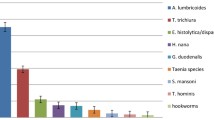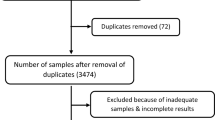Abstract
Intestinal parasites are a constant public health problem in the Amazon region, with a high prevalence of cases related to poor sanitary conditions. We investigated the sociodemographic and seasonal factors associated with human intestinal parasite infections in an area of the Western Amazon, Brazil, from September 2017 to August 2019. Data were collected using a database available at the Diagnostic Support Centre (Centro de Apoio ao Diagnóstico, CAD) of the Municipality of Rio Branco, on positive diagnoses for intestinal parasites. Among the 53,200 samples analysed, 18.3% (n = 9712) were positive. Of these, 96.4% (n = 9363) and 3.6% (n = 349) were protozoan and helminthic infections, respectively. Males showed higher odds ratio (OR) for Enterobius vermicularis infection (OR: 2.3) and giardiasis (OR: 1.9) and lower OR for Endolimax nana (OR: 0.9) and Entamoeba coli (OR: 0.9) infections. Individuals aged ≥ 15 presented higher OR for Strongyloides stercoralis (OR: 3.4), hookworms (OR: 2.3), and almost all protozoan infections than younger individuals. In the dry season, the OR for hookworms (OR: 1.5), Iodamoeba butschlii (OR: 1.4), and Endolimax nana (OR: 1.3) infections was higher than that in the rainy season, including a high chance of polyparasitism (OR: 1.6). We concluded that there was a significant difference between the different types of intestinal parasites, particularly protozoa, with high OR in the dry season and for certain groups.
Similar content being viewed by others
Data availability
The dataset used in this study are available from the corresponding author on reasonable request.
References
Balbino LF, Alves A, Farias BES, Costa GV, Sinhorin GH, Silva LLS, Marques RCR, Jucá FL, Brilhante AF, Melchior LAK (2021) Intestinal protozoan infections and environmental conditions among rural school children in Western Brazilian Amazon. Braz J Biol 83:e247530
Casavechia MT, Lonardoni MV, Venazzi EA, Campanerut-Sá PA, da Costa Benalia HR, Mattiello MF, Menechini PV, Dos Santos CA, Teixeira JJ (2016) Prevalence and predictors associated with intestinal infections by protozoa and helminths in southern Brazil. Parasitol Res 115:2321–2329
de la Luz Galván-Ramírez M, Madriz-Elisondo AL, Ramírez CGT, de Jesús Romero Rameño J, de la O Carrasco DA, López MAC (2019) Enteroparasitism and risk factors associated with clinical manifestations in children and adults of Jalisco State in Western Mexico. Osong Public Health Res Perspect 2019(10):39
Dessie A, Gebrehiwot TG, Kiros B, Wami SD, Chercos DH (2019) Intestinal parasitic infections and determinant factors among school-age children in Ethiopia: a cross-sectional study. BMC Res Notes 12:1–6
Duarte AF (2006) Aspectos da climatologia do Acre, Brasil, com base no intervalo 1971–2000. Rev Bras Meteorol 21(3b):308–317
Eslahi AV, Badri M, Nahavandi KH, Houshmand E, Dalvand S, Riahi SM, Johkool MG, Asadi N, HoseiniAhangari SA, Taghipour A, Zibaei M, Khademvatan S (2021) Prevalence of strongyloidiasis in the general population of the world: a systematic review and meta-analysis. Pathog Glob Health 2021(115):7–20
Faria CP, Zanini GM, Dias GS, da Silva S, de Freitas MB, Almendra R, Santana P, Sousa MD (2017) Geospatial distribution of intestinal parasitic infections in Rio de Janeiro (Brazil) and its association with social determinants. PLoS Negl Trop Dis 11(3):e0005445
Fernandes NS, Guimarães HR, da Silva AAC, Brito VM, Borges EP, Reis MB, Trindade RA, Melo ACFL (2014) Ocorrência de enteroparasitoses em manipuladores de alimentos de restaurantes em Parnaíba, Piauí-Brasil. Rev Patol Trop 43:459–469
Harvey TV, Tang AM, da Paixao SA, Albano Dos Santos C, Santos Carvalho SM, Magalhães da Rocha CMB, Oliveira BCM, Albuquerque GR (2020) Enteric parasitic infections in children and dogs in resource-poor communities in northeastern Brazil: identifying priority prevention and control areas. PLoS Negl Trop Dis 14:e0008378
IBGE (2022) Instituto Brasileiro de Geografia e Estatística. Available from: https://cidades.ibge.gov.br/brasil/ac Access on 12 May 2022
Mariano APM, Santos EN, Santos TN, Mota TN, Silva JA, Carvalho SMS, Silva MF (2015) Parasites in South Bahia: focus on giardiasis and ascariasis among preschoolers of Itabuna. Int J Health Sci 3(1):61–75
Muniz PT, Castro TG, Araújo TS, Nunes NB, da Silva-Nunes M, Hoffmann EH, Ferreira MU, Cardoso MA (2007) Child health and nutrition in the Western Brazilian Amazon: population-based surveys in two counties in Acre State. Cad Saúde Pública 23:1283–1293
Oliveira FB, Correia TPD, Neves LBD, Teixeira PEF, Moreira JC, Souza LS, Neves RH, Almeida FB, Boia MN, Silva RR, Silva JRM (2022) Spurious infection by Calodium hepaticum (Bancroft, 1983) Moravec, 1982 and intestinal parasites in forest reserve dwellers in Western Brazilian Amazon. Rev Inst Med Trop Sao Paulo 2(64):e2
Paula FM, Costa-Cruz JM (2011) Epidemiological aspects of strongyloidiasis in Brazil. Parasitology 138:1331–1340
Pawestri AR, Thima K, Leetachewa S, Maneekan P, Deesitthivech O, Pinna C, Yingtaweesak T, Moonsom S (2021) Seasonal prevalence, risk factors, and one health intervention for prevention of intestinal parasitic infection in underprivileged communities on the Thai-Myanmar border. Int J Infec Dis 105:152–160
R Development Core Team (2019) R: a language and environment for statistical computing. R Foundation for Statistical Computing. Available from: https://www.r-project.org. Accessed 1 Dec 2021
Rivero MR, De Angelo C, Feliziani C, Liang S, Tiranti K, Salas MM, Salomon OD (2022) Enterobiasis and its risk factors in urban, rural and indigenous children of subtropical Argentina. Parasitology 49:396–406
Toledo R, Muñoz-Antoli C, Esteban JG (2015) Strongyloidiasis with emphasis on human infections and its different clinical forms. Adv Parasitol 2015(88):165–241
WHO. World Health Organization – WHO. Soil-transmitted helminth infections, 2020. Available from: https://apps.who.int/neglected_diseases/ntddata/sth/sth.html Accessed 27 June 2022
Acknowledgements
The authors thank the Diagnostic Support Center (Centro de Apoio ao Diagnóstico — CAD) of the Municipality of Rio Branco, Acre, for allowing access to the data. To Mr. Ademir Antonio Sinhorin, for his collaboration in organizing the data.
Funding
This study was financed by the authors’ resources.
Author information
Authors and Affiliations
Contributions
GHS and AFB conceived and designed the study. GSF, ACGC, BESF, and PA collected and organized the data. GHS, AFB, ARMS, and LAKM analysed data and drafted the manuscript. All authors read, revised, and approved the final version of the manuscript.
Corresponding author
Ethics declarations
Ethics approval
This study was approved by the Ethics Committee in Research involving Human Beings of the Federal University of Acre, under opinion number CAAE 26898419.8.0000.5010.
Consent to participate
Not applicable.
Consent for publication
Not applicable.
Conflict of interest
The authors declare no competing interests.
Additional information
Handling Editor: Una Ryan
Publisher's note
Springer Nature remains neutral with regard to jurisdictional claims in published maps and institutional affiliations.
Supplementary Information
Below is the link to the electronic supplementary material.
Figure S1
Fourfold plot for statistically significant independence tests (p<0.05) between detection of intestinal parasites and sex. (PNG 89 kb)
Figure S2
Fourfold plot for statistically significant independence tests (p<0.05) between the detection of intestinal parasites and age group. (PNG 108 kb)
Figure S3
Fourfold plot for statistically significant independence tests (p<0.05) between detection of intestinal parasites and season (dry and rainy months). (PNG 86 kb)
Rights and permissions
Springer Nature or its licensor (e.g. a society or other partner) holds exclusive rights to this article under a publishing agreement with the author(s) or other rightsholder(s); author self-archiving of the accepted manuscript version of this article is solely governed by the terms of such publishing agreement and applicable law.
About this article
Cite this article
Sinhorin, G.H., Carneiro, A.C.G., Farias, B.E.S. et al. Intestinal parasite infections associated with sociodemographic and seasonal factors in the Western Amazon. Parasitol Res 122, 419–423 (2023). https://doi.org/10.1007/s00436-022-07736-9
Received:
Accepted:
Published:
Issue Date:
DOI: https://doi.org/10.1007/s00436-022-07736-9




